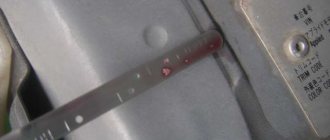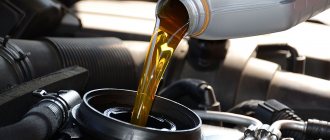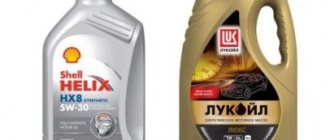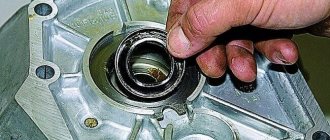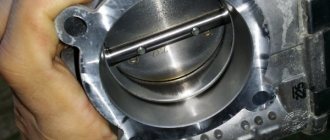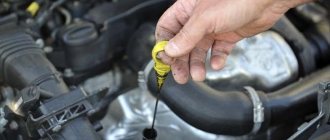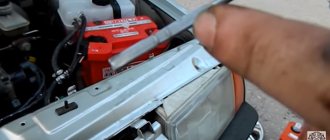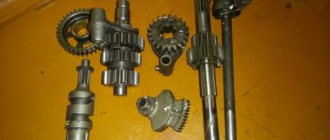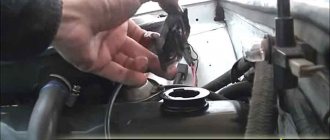There is a white emulsion on the dipstick - what is it?
The basis of inexpensive motor oil is hydrocarbons. Alcohol, peroxides and other substances formed during the combustion of the fuel mixture cannot dissolve in it. When the car moves, all undissolved components are actively mixed - the result is an emulsion. The substance acquires its white color due to the large number of tiny bubbles.
If the working fluid is significantly contaminated, the emulsion may take on a beige color. It sticks easily to a cold dipstick. The consistency of the emulsion resembles mayonnaise. It forms in large quantities on the filler cap for filling the working fluid.
Emulsion - what is it and where does it come from?
Lubricants for automobile engines, which can be purchased at any auto supply store, are made on the basis of hydrocarbons. During the combustion of a combustible mixture, combustion products are formed. Gasolines may contain water, alcohol, acid, and peroxide. Then these substances are mixed with oil during engine operation. As a result, there is an emulsion in the engine. It appears on the filler cap or on the dipstick to check the lubricant level.
Many people are interested in the reasons for the formation of emulsion on the lid and on the dipstick. This can be explained simply. Due to the large number of small bubbles, the emulsion becomes white. This indicates that the oil is very dirty. Also, both the dipstick and the cover are the coldest elements of the engine. Therefore, slurry accumulates well on these elements.
Causes of emulsion in the engine
The main reason why an emulsion forms in the engine and on the inner surface of the oil filler cap is moisture getting into the oil. The more it is, the more severe the consequences. He can get there for two reasons:
- in the form of evaporating condensate from the internal walls of the engine;
- due to depressurization of the oil system or cooling system.
Table of reasons for the appearance of emulsion and methods for eliminating it.
| Why does an emulsion form? | Causes of failure | Testing and elimination methods |
| Evaporation of condensate on a hot engine | Insufficient warming up of the engine to operating temperature | After starting, especially in winter, before leaving, warm up the engine to a temperature of +90°C |
| Stopping a still slightly warmed-up engine when an emulsion forms | Drive a car with a warm engine for 10…15 kilometers or more | |
| Antifreeze getting into the oil | Blown head gasket | Replacing the gasket, tightening the bolts in the correct sequence and with the required torque |
| Violation of cylinder head geometry | Crimping, milling, grinding of cylinder head | |
| Burnt heat exchanger gasket | Replacing the oil cooler gasket | |
| Damage to the cylinder block | Repair or replacement of the unit | |
| Corrosion of sleeves | Boring sleeves or replacing them with new ones | |
| Incorrect connection of the cooling system | System audit, connection according to the diagram |
Condensation from the air
When it is just condensation in the engine, the emulsion usually forms only on the cap and the edges of the engine filler neck. There should be no beige foam in the oil itself. Such an emulsion is formed due to a temperature difference when moisture, evaporating, settles on the neck cover, and during intensive engine operation mixes with oil droplets. If the trip is short (up to 10 minutes), then it will not have time to disappear. You can drive with condensation in the engine without fear. This condensate evaporates 15 minutes after the engine warms up to operating temperature. If the car is constantly used for short trips, then the emulsion will be on the lid almost constantly.
Antifreeze went into the oil
When a yellow or brown emulsion is not just on the oil cap or the edges of the neck, but is visible inside the engine, then it’s worth disassembling the engine and looking for the cause, it shouldn’t be like this. You can't drive with this oil mixture for long!
Reasons for the formation of emulsion in the engine
Traces of emulsion on the surface of the oil filler cap
- burnout of the cylinder head gasket;
- violation of the geometry of the cylinder head housing;
- breakdown of the heat exchanger, puncture of its gasket;
- damage to the engine cylinder block (usually some kind of microcrack);
- corrosion of liners in the engine, or their mechanical damage (wear);
- Incorrect connection of the cooling system to the throttle valve.
In VAZ cars of “classic” models, among other things, the problem can arise due to crumbling plugs located on the cylinder head. For example, on the engine of a VAZ-2101 there are three of these plugs - two on the outer surface of the head, and one on the outside.
How to deal with “condensation emulsion”
To avoid the formation of a “condensate emulsion”, it is enough to follow a few simple rules and recommendations:
- You should not warm up the engine for a long time while parked, since at idle the crankcase ventilation system is almost not activated. Moreover, fully warming up the engine to operating temperature in cold weather takes a lot of time. It is recommended to leave the parking lot after 5–8 minutes of warming up. This is exactly how long it will take to clear the snow from your car. We cleared the car of snow and drove off. When driving (at gentle speeds), the unit will heat up to operating temperature much faster and better.
- As mentioned above, it is advisable to reduce the number of short trips during which the engine does not have time to warm up to operating temperature.
- Periodically take long trips to allow the engine to warm up well and run at high speeds to evaporate condensation.
- Use additives for motor oils - demulsifiers (to break the emulsion).
- Use special motor insulation.
Description of the problem
A dipstick is used to check the lubricant level in the engine crankcase. When the element is removed from the engine, a cloudy white or yellowish coating mixed with engine oil appears on the surface. A similar emulsion is formed on the inner surface of the plug installed in the hole for filling lubricant into the engine. The car owner needs to understand why the foreign deposit has formed.
Why does emulsion appear in oil: causes and consequences
The emulsion looks like fine white foam and is formed when water or other liquid gets into the engine oil, followed by active mixing. In some cases, such plaque does not pose a danger and there is no need to worry about its presence. But this is not always the case; an emulsion in the engine oil may also indicate serious problems with the power plant and the need for repairs.
The presence of water in oil is generally considered unacceptable since it affects the performance and characteristics of the lubricant. But the design of any engine includes a breather, which ensures that a given pressure is maintained in the crankcase. Essentially, it connects the internal space of the power plant with the atmosphere. Therefore, through it, air from the environment enters the cylinder block, which necessarily contains moisture - water particles.
In summer, the temperature difference is low, so most of the water remains in a gaseous state and is then removed along with crankcase gases. In winter, the temperature difference is significant, so moisture condenses into liquid, settles on the internal surfaces of the engine, where it is mixed with the engine oil. This is where the white emulsion on the oil filler cap comes from.
Therefore, the presence of a slight whitish coating on this filler cap or oil level dipstick in winter is normal, and there is nothing bad about it.
Video: Emulsion under the valve cover!!!
But the appearance of a yellow emulsion on the oil filler cap in the summer or a significant amount of it indicates problems with the engine. The same applies to traces of emulsion on the engine oil dipstick. In a working engine, foam does not appear on it even in winter, and if it is detected, malfunctions have appeared in the engine.
Where to look for the cause of an antifreeze leak?
A leak can occur due to:
- block heads;
- cylinder head gaskets;
- cracks in the cylinder;
- cracks in the block head.
Let's start with the block head. This component of the engine is made of non-ferrous metals and, when installed, is strongly bolted to the cylinder block.
As a result of metal expansion due to overheating, the head warps. In some places, gaps appear between the cylinder head and the block, through which technical fluids enter the channels of other systems. That is, the coolant simply reaches the oil channels through the cracks and is mixed with the lubricant.
This malfunction is not very complex and can be easily repaired. But this will require dismantling the head, grinding its surface adjacent to the block, replacing the gasket and lubricant. When changing, it is necessary to flush the engine and lubrication system and replace the “old” oil with antifreeze impurities.
But warping of the block head causes the formation of an emulsion not so often. A more common problem is a cylinder head gasket failure.
This happens for the same reason - engine overheating. But if the head warps only when exposed to high temperatures for a long time, then short-term overheating is sufficient to damage the gasket. And since lubrication and cooling channels pass through the gasket, the jumpers between them are destroyed by high temperature. Note that a breakdown does not always occur only between channels. Damage can also connect the channels to the cylinder or lead outside the engine.
Although a cylinder head gasket failure is the most common reason for the appearance of a white emulsion in engine oil, it is also considered the easiest to fix. To do this, you just need to replace the damaged gasket with a new one, as well as change the engine oil and flush the engine. An experienced car enthusiast can carry out repairs within 4-5 hours.
Although cracks in the cylinder rarely occur, they can also cause the formation of an emulsion. This usually occurs due to defects in the metal structure of the liner.
Video: Emulsion on the oil filler cap
Over time, existing defects can lead to the appearance of a crack in the cylinder wall, and as it cools, liquid begins to leak into the combustion chambers. Most of the fluid leaves the engine through the exhaust pipe, but some of it also gets into the sub-piston space, which is where the emulsion comes from.
It is possible to repair an engine with such a breakdown only if the liners in it are removable and can be replaced. But in a number of power plants, the cylinders cannot be removed, and in this case the entire block must be replaced.
Another serious problem, the consequence of which is the formation of an emulsion in motor oil, is cracks in the head and block. They can form from overheating, internal metal defects, or shock loads.
Such damage is very difficult to identify, especially in the block, since the lubrication and cooling channels pass inside it, and it is not always possible to inspect or diagnose them.
It will also be impossible to repair such damage. Therefore, the engine part with the crack is simply replaced.
In order to avoid unscheduled engine repairs due to the appearance of an engine oil emulsion, it is only sufficient to carry out timely maintenance, especially regarding the replacement of technical fluids, and also to prevent the engine from overheating. And to do this, you should constantly monitor the temperature while driving.
If a problem with the emulsion in the engine oil appears, it is better to start the search with the simplest thing - the cylinder head gasket. In this case, after dismantling the head when replacing it, you should check it for warpage. This is very easy to do even in a garage. To do this, place the head with the surface adjacent to the block on clean glass. The irregularities formed as a result of warping will be clearly visible.
Usually the reason lies in the head and its gasket. Cracks in liners, block and cylinder head are very rare.
Masters who professionally service cars advise changing the oil every 10 thousand kilometers. However, even if these recommendations are followed, car owners see that there is an emulsion in the engine. Its consistency is similar to mayonnaise. This composition brings both experienced car owners and beginners into a real shock. This liquid can have different colors. What is it and why is emulsion dangerous? We will consider the answers to these questions in our article today.
Emulsion in engine oil: reasons
Why does an emulsion form? There may be several reasons, but there are only three main ones:
- mixing oil and water
- mixing oil with coolant;
- use of low-quality fuel.
Condensate
If the car is left outside for a long time in humid weather, water vapor enters the crankcase, collecting on the tubes and on the very surface of the working fluid. Moisture enters the crankcase through the cooling system. It can also penetrate through the cylinders, but this is a rather rare occurrence. To form “mayonnaise”, 2 grams of condensate is enough.
Gasket failure
An emulsion on the oil level dipstick may form due to damage to the cylinder head gasket. This occurs due to its burning out during overheating or due to normal physical wear. The gasket installed at the factory will last a long time, and it makes sense to check its condition only 10 years after the vehicle has been in use. But if the operation of the motor is unstable, wear may begin earlier.
If working fluid from the cooling system gets onto the gasket, it also does not help to increase its service life. You'll have to take it out and replace it with a new one.
Cracks
Cracks in the BC or on its head can appear after any, even the most minor, accident. In frosty weather, it is enough to drive over the curb. Also, such damage occurs due to freezing of the coolant. Therefore, ordinary water cannot be used for cooling. It will definitely remain even after draining, and as a result of its freezing, the BC channels may rupture.
Crankcase ventilation does not work
Over time, the ventilation becomes clogged. But since the vapors from the crankcase need to escape through something, they will do this through the dipstick. Emulsion will begin to accumulate under the oil fill cap or dipstick holder. After repairing the ventilation system, it is not necessary to change the oil.
Antifreeze getting into the oil
Antifreeze can get into the oil due to increased pressure in the cooling circuit. As a result, the coolant is squeezed out. Antifreeze and other types of antifreeze are also insoluble in oil, which leads to the formation of a white emulsion.
Excessive pressure in the cooling system can be caused by hot gases entering it through a breakdown in the gasket. Then traces of a white substance can be detected even in the exhaust gases.
Poor quality fuel
This is the most common reason for the formation of white plaque. Low-quality fuel contains alcohol, kerosene and water. When using propane-butane, the appearance of a white coating will be promoted by the use of “wet” gas with cleaner residues.
Why does it occur in winter?
In winter, the accumulation of condensation is facilitated by moving the car over short distances without preheating the engine to 90 degrees. A car that is parked in an insulated garage is not immune from condensation. Moisture will appear due to temperature changes.
Consequences of emulsion in the engine
The formation of a foam emulsion in oil can lead to the following consequences:
- oil characteristics change;
- engine parts are poorly lubricated (in particular, main and connecting rod bearings, valves, cylinder walls, piston group), which leads to a decrease in their service life and the service life of the entire engine;
- Engine power decreases.
If the emulsion in the engine is formed not in the oil system, but in the cooling system, this can lead to the following consequences:
- frequent overheating of the engine, boiling of the coolant;
- the emulsion clogs pipes and hoses to a critical level when antifreeze circulation is impossible;
- reduction in the service life of the engine and its individual parts.
Therefore, when an emulsion is formed in individual parts of the engine, there is no need to “turn a blind eye” to this. Instead, you need to find out as quickly as possible why it forms and take repair measures.
Let's sum it up
Diesel oil has been used by car owners for many decades as an effective and gentle means for washing the power unit. Today, the effectiveness of the diesel fuel flushing procedure is questioned by many automakers and service center employees; alternatives are considered to be the use of specific liquids to clean the engine. However, a detailed study of the composition of special emulsions for washing the engine raises doubts and controversial issues, since effective removal of soot and dirt using special liquids is achieved due to the presence of aggressive chemical components in them, which can also negatively affect the unit components.
As many years of practice have proven, the method of flushing the engine with diesel fuel has a right to exist, is characterized by high efficiency against the backdrop of low costs, and is considered a gentle way to clean the engine. Each car owner has the right to decide independently which product to choose; however, when performing the flushing, you should act very carefully, follow the instructions, do not overheat the engine - and the result will live up to expectations. Better yet, keep an eye on the engine of your car, try to avoid overheating and stress, change the oil in a timely manner - and the engine will not need such procedures.
Additional symptoms of trouble
As already noted, an emulsion is a mixed mixture of water and oil in the form of foam. A copious amount of white or yellowish foam on the cover and dipstick indicates that liquid is leaking into the engine crankcase, and it is present only in the cooling system. Therefore, the location of the leak should first be looked for in those parts of the engine where the lubrication and cooling channels run nearby.
Note that the appearance of a coolant leak inside the engine may be accompanied by a number of other signs:
- A constant decrease in the coolant level in the expansion tank and the need for periodic topping up.
- Oil film in the expansion tank.
- The interior heating system provides virtually no heat.
- The engine oil level is higher than normal.
- Copious white smoke from the exhaust pipe.
- Interruptions in engine operation.
All this indicates that antifreeze has entered the oil channels. If you do not take any action and continue to operate the car, the engine will be damaged due to lack of normal lubrication, and expensive major repairs or a complete replacement of the engine will be required to restore functionality.
Faulty crankcase ventilation system
If the ventilation system is clogged and does not work as it should, then gases and vapors will try to escape through the dipstick and other places in the internal combustion engine. In this case, it is not surprising that an emulsion appeared on the oil filler cap.
The only good thing is that the oil is clean and there is no antifreeze in it. If you fix the crankcase ventilation system, then you won’t even have to replace it
lubricants.
Video
Emulsion under the valve cover
Do not be alarmed if you find an emulsion under the oil filler cap, but the oil on the dipstick is in normal condition. The accumulation of plaque, whose consistency and color resembles condensed milk, occurs due to moisture condensation. The autumn-winter period and frequent trips over short distances are the most favorable conditions for the accumulation of condensation.
In the crankcase ventilation system, air mixed with combustion products of the air-fuel mixture and oil vapor has a certain percentage of humidity. The heated mixture inevitably condenses on cooled surfaces. But when the engine and all its parts warm up, the moisture gradually evaporates. With frequent cold starts and short runs, some elements do not have time to warm up to the temperature required for evaporation. As a result, the emulsion accumulates under the oil filler cap.
Is it possible to overcome the problem?
The emulsion itself under the engine cover is not dangerous. It is enough to wipe it occasionally with a clean cloth. If the car is the second in the family and is used only in the city, try to periodically go on the highway with it. Long periods of operation within the operating temperature range will prevent emulsion accumulation.
On gasoline internal combustion engines, frequent cold starts and short distances are also dangerous due to the accumulation of gasoline in the oil. In the start-up and warm-up modes, the ECU enriches the mixture, which causes more gasoline to enter the crankcase through the piston rings. Fuel dilutes the oil and impairs its lubricating properties. Under such conditions, loaded friction pairs wear out intensively: cylinder walls, liners, crankshaft journals, camshafts. When a warm engine runs for a long time, gasoline naturally evaporates from the oil and enters the intake manifold through the crankcase ventilation system.
Pay attention to the crankcase ventilation system
Much more dangerous is the accumulation of condensate in remote oil separators, tees and hoses of the crankcase ventilation system. This situation occurs in severe frost and most often after long periods of idle time. At idle speed, a small amount of exhaust gases breaks into the crankcase, while the vacuum in the intake manifold is close to maximum (the throttle is closed or slightly open at a small angle). In order not to create unnecessary vacuum in the crankcase, the system takes in air through a hose cut into the corrugation up to the throttle valve. When heated gases mix with frosty air in the tee, the accumulating condensate freezes, blocking the passage of crankcase gases. In the best case, after this, the gases push out the dipstick, splashing the engine compartment with oil, in the worst case, they squeeze out the seals.
How to diagnose a malfunction?
It is better to start diagnostics by checking the coolant level. If the antifreeze level drops without obvious reasons, this may indicate a cylinder head malfunction or a gasket failure. In the second case, the engine runs unevenly, and antifreeze leaves the cooling system.
To check the oil for the presence of coolant, it must be drained into a clean container. The engine should be warmed up, as the oil should be warm.
Pay attention to what the working fluid looks like. In the heated oil, traces of the coolant will be clearly visible, which, as it cools, turns into an emulsion. If the antifreeze is diluted with water, the bulk of it is concentrated at the bottom of the crankcase and is drawn in by the oil receiver. There may be no traces of emulsion on the dipstick, but you cannot drive such a car, since the viscous substance will clog the lubrication channels. The consequence may be failure of the engine valve or connecting rod bearings.
The appearance of an emulsion on the neck cover indicates the destruction of the cylinder head gasket. Confirmation of gasket wear will be the leakage of working fluid from the tank. When inspecting the power unit, check the junction of the cylinder head and cylinder head. The presence of smudges in this place will confirm an oil leak.
If a thick white color comes out of the exhaust pipe, this is evidence of coolant getting into the engine elements. This is true for all types of power units. However, for diesel engines the coolant enters the manifold, and for gasoline engines it enters the cylinders.
Methods to diagnose the problem
In order to determine the quality of the oil, it must be drained from a warm engine into a suitable container. After this, you need to take a closer look at the waste material; traces of emulsion or foreign liquids may be visible in it, since they differ in color from oil and do not mix well with it. If water is present, most of it will end up at the bottom of the crankcase. Liquid is often sucked into the oil receiver. You also need to check the lubrication channels; they become clogged with a thick mixture, after which the oil cannot flow to the engine parts in the required quantity. This can cause twisting of the connecting rods, failure of the piston rings or engine valve.
What measures should the driver take?
If diagnostics revealed a damaged cylinder head gasket, it should be replaced. To replace the gasket you will have to remove the head. After installing the gasket, it is better to tighten the mounting bolts using a torque wrench so that the specified tightening torque is not exceeded. If the cylinder head “leads”, the problem can only be solved by turning it on a machine. It is better to entrust this work to specialists.
If the heat exchanger is damaged, it is sealed, if, of course, this is possible. If not, the heat exchanger is changed. If errors were made when connecting the main line of the cooling system, all pipes will have to be disconnected and reconnected.
If the BC is damaged, the unit will have to be dismantled. At the same time, the block is bored and sleeved.
If leaks of coolant are detected in the pipes and connections, the leak must be eliminated. Then you will have to change the engine oil and antifreeze, after flushing the cooling system. Such leaks are diagnosed when the engine is running at high speeds. The liquid will flow out under pressure, and finding the leak will not be difficult.
Engine oil and the engine itself should be checked as often as possible. This is the only way to prevent serious damage.
What is the engine lubrication system?
This system, by reducing the frictional forces of the elements, increases the life expectancy of all components of the device. As an addition, oil removes excess heat that is generated during the operation of components or a specific element. In order to achieve the maximum positive effect from the lubrication system, it is important to fill in the engine oil that will fully correspond to the operating modes of the engine.
The main components that make up the engine lubrication system:
- Filter.
- Oil pump.
- The oil pan contains most of the oil.
- Hoses and supply tubes.
The system is perfectly sealed, so it will be problematic for other liquids to get there. This was achieved by installing many gaskets and seals.
When the engine starts, the oil pump starts working and gradually increases the pressure. Oil flows through the system, having previously passed through a cleaning filter. The fluid primarily lubricates the components where severe wear is possible - the crankshaft journal, camshafts and valves. After which it drains into the crankcase, where it hits the connecting rod and is scattered onto the cylinder walls. Next, the oil scraper rings clean the cylinders. The entire lubrication process is uninterrupted and lasts as long as the motor is running.
How to flush the emulsion in the engine
Flushing the engine to remove emulsion is only necessary if it is formed as a result of antifreeze getting into the oil. If it appears as a result of heating, then there is no need to wash the emulsion, just warm up the engine thoroughly.
In order to flush the internal combustion engine from emulsion and other debris (especially if the oil is already old), you need to use special flushing oils. Or you can use the “old-fashioned” method. It consists of mixing diesel fuel and mineral oil (you can even use waste oil) in volumetric proportions of one to three. And then perform two or three engine flushing cycles at idle speed. If special flushing oil is used, then one flushing cycle lasting 15...20 minutes is usually sufficient. Then fill with fresh engine oil and change the oil filter.
Conclusion
Typically, an emulsion on the oil filler cap forms in winter or in the off-season. Emulsion in the engine in warm summer weather should be a concern. The first thing you need to do is check the level of antifreeze in the expansion tank, the presence of white smoke from the exhaust pipe, and also remember in what modes the car is usually used. After this, warm it up thoroughly and drive 10...15 kilometers, then check the cover. Most often, the cause of the appearance of an emulsion is precisely the accumulation of condensation on a hot engine, but it can also occur due to an engine malfunction, in which case the oil and cooling systems will have to be checked.
Ask in the comments. We will definitely answer!
Flushing the engine oil system: when needed
So, antifreeze or antifreeze can get into the lubrication system for various reasons, but the most common culprit is damage to the cylinder head gasket. Less commonly, cracks form in the block or head. In any case, the result of mixing oil and coolant is an emulsion.
This phenomenon is very dangerous for the engine, since the lubricant loses its properties, and the wear of the cylinder head, crankshaft, timing gear and other elements and components in the internal combustion engine increases significantly. Moreover, water and ethylene glycol, mixed in certain proportions and, in fact, representing coolant, after entering the oil, cause coagulation of various contaminants.
Simply put, dirt in the lubrication system literally sticks together. Additives in oil and antifreeze react after mixing and quickly decompose, the oil immediately oxidizes, etc. Large “lumps” consisting of deposits can even clog the oil receiver mesh filter, resulting in oil starvation of the engine.
It is important to take into account that, for example, after replacing the cylinder head gasket, it will not be possible to completely drain the waste from the engine. This means that if you fill in a new portion of fresh lubricant, the lubricant will also mix with the remaining emulsion, and unwanted deposits will still form in the oil channels and on the internal surfaces of the engine.
If the engine is not additionally flushed, this situation will repeat for at least 2-3 more replacements. We also note that similar recommendations also apply when, for some reason, the oil change interval was violated (for example, the lubricant was replaced not after 10 thousand km, but after 15 thousand). Flushing is also recommended if it is necessary to add oil from a third-party manufacturer, when it was necessary to mix mineral oil and synthetics, etc.
At the same time, flushing the engine may be necessary if the owner purchased a used car, and the service history of a particular car is unknown or questioned. It often happens that after changing the oil on such a machine, the fresh lubricant turns black very quickly (literally after 50-100 km).
Finally, it is also worth highlighting the possible filling of low-grade oil into the engine. Unfortunately, fakes are often found among motor oils. Naturally, after discovering this fact, you need to remove the surrogate from the internal combustion engine, then the engine must be flushed.
A counterfeit product is usually indicated by strong and rapid blackening of the lubricant, an unpleasant pungent odor, the appearance of black deposits under the valve covers, cloudiness of the oil, a significant change in its viscosity for no obvious reason, increased lubricant consumption, engine smoking, etc.
Ways to deal with condensate emulsion
To avoid the appearance of an emulsion of a condensate nature, you must follow these simple recommendations:
- You should not get carried away with warming up your car for a long time after a long period of parking. The reason is obvious - when the engine is running at idle, the crankcase ventilation system is practically not involved. Moreover, in winter, reaching operating temperature without load can take a very long time. In reality, it is enough to let the power unit work for 5-10 minutes - this is enough to, for example, clear the car of ice and snow. True, you can’t immediately accelerate, but if you move at gentle speeds, the engine temperature will rise to the operating level much faster and with less consequences;
- short trips should be avoided, especially in winter, since the engine, without having time to warm up, is forced to work under load;
- to get rid of condensation, it is necessary from time to time to make long trips at cruising speeds - this is the ideal mode for evaporating condensation that has managed to form;
- you can try using emulsifiers - special additives that prevent the formation of condensation;
- Finally, insulating the engine in winter will also reduce the risk of condensation emulsion.
Note that flushing the engine from emulsion is practically not used in this case.
Broken gasket
Most often, liquid in the oil appears due to a breakdown in the cylinder head gasket. A leak usually occurs either due to overheating (the gasket burns out) or due to physical wear of the gasket. When an engine overheats, you should always check the condition of the oil. An engine that is more than ten years old may have a gasket that has simply physically worn out.
If the engine begins to operate unstably, then it is necessary to check the gaskets. Liquid may leak from the cooling system. If detected in a timely manner, this malfunction can be easily eliminated by simply replacing the gasket with a new one. You may not even have to sand.
Cylinder head gasket breakdown or cracks in it
Cracks in the gasket may appear as a result of its wear; the second reason is engine overheating. Most often, the cylinder head itself is damaged in used engines that have not seen good care. It is quite easy to notice a gasket malfunction: the engine will stop working stably, antifreeze will begin to abruptly leave the tank, but there will be no visible leaks.
The gasket can also crack due to severe frosts, when a low-quality cooling liquid was used or it froze. The amount of antifreeze and temperature sensor readings must be checked regularly and the liquid level monitored. You should not use water instead of special liquids or dilute them with it. When it's cold, water freezes and the channels through which fluid is supposed to move crack. Icing of water can also lead to engine deformation. Water in the crankcase may appear due to worn engine valves or faulty rings.
